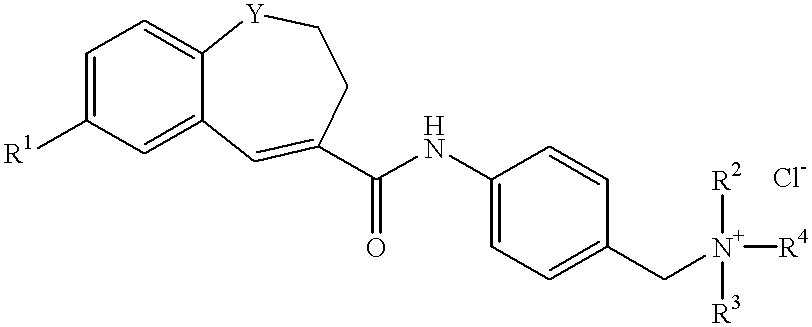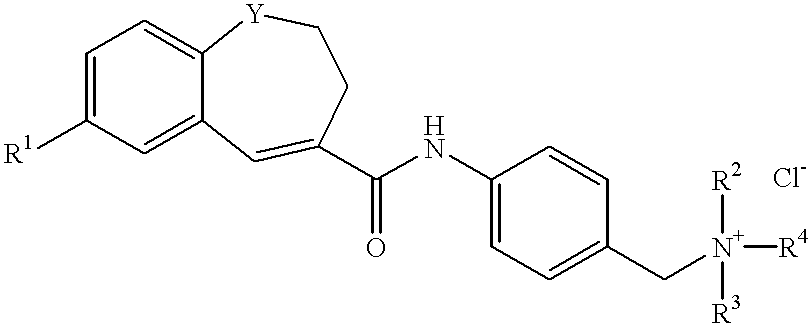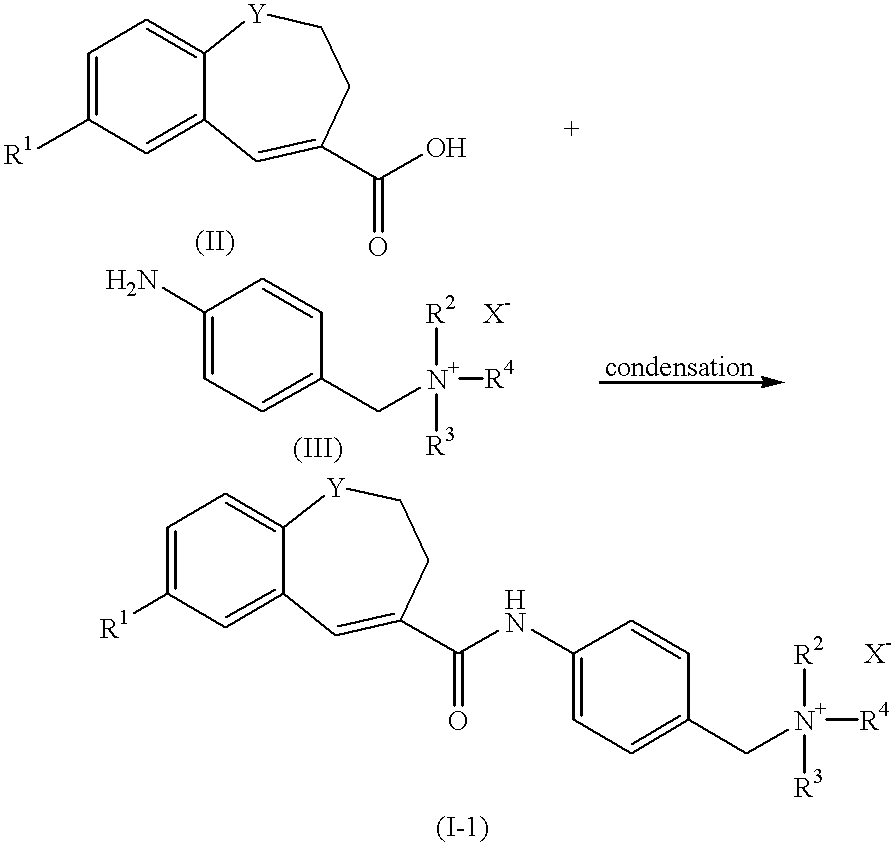Quaternary ammonium salts and their use
a technology of ammonium salt and ccr5, which is applied in the field of quaternary ammonium salt, can solve the problems of aids that are not sufficient for the elimination of their combination use, and the report that a ccr5 antagonist is developed as a therapeutic agent of aids
- Summary
- Abstract
- Description
- Claims
- Application Information
AI Technical Summary
Benefits of technology
Problems solved by technology
Method used
Image
Examples
reference example 1
To a solution of 4-nitrobenzylalcohol (50 g, 0.326 mol) in ethyl acetate (EtOAc) (200 ml) were added 3,4-dihydropyran (35.7 ml, 0.392 mol) and CSA (camphor sulfonic acid) (379 mg, 1.63 mmol) under stirring at room temperature, and the mixture was stirred at room temperature for 1 hour. After the reaction completed, the reaction mixture was neutralized with saturated NaHCO.sub.3 solution and separated ethyl acetate layer was dried with MgSO.sub.4 and concentrated under reduced pressure. The residue was purified with silica gel column chromatography to give 4-(2-tetrahydro-pyranyloxymethyl)nitrobenzene (74.5 g, 96%) as syrup.
.sup.1 H-NMR (200 MHz, CDCl.sub.3) .delta.: 1.55-2.05 (6H, m), 3.51-3.62 (1H, m), 3.83-3.94 (1H, m), 4.61 (1H, d, J=13.6 Hz ), 4.74 (1H, t, J=3.2 Hz), 4.93 (1H, d, J=13.4 Hz), 7.51-7.56 (2H, d, J=8.8 Hz), 8.18-8.24 (2H, m).
reference example 2
To a solution of 4-(2-tetrahydropyranyloxymethyl)nitrobenzene (59.7 g, 0.256 mol) in ethanol (EtOH) (300 ml) was added under nitrogen atmosphere at room temperature 10% Pd / C (5.97 g), and catalytic hydrogenation was carried out. The mixture was stirred at room temperature for 24 hours. After the reaction completed, the catalyst was filtered off, and the organic layer was concentrated under reduced pressure. The residue was purified with silica gel column chromatography to give 4-(2-tetrahydropyranyloxymethyl)-aniline (39.7 g, 76%) as syrup.
.sup.1 H-NMR (200 MHz, CDCl.sub.3) .delta.: 1.45-1.95 (6H, m), 3.00-3.60 (3H, br m), 3.87-4.14 (1H, m), 4.39 (1H, d, J=11.4 Hz), 4.68 (1H, d, J=11.4 Hz), 4.71 (1H, m), 6.65-6.69 (2H, m), 7.15-7.19 (2H, m).
reference example 3
To a solution of 2-(4-methylphenyl)-6,7-dihydro-5H-benzocycloheptene-8-carboxylic acid (35.0 g, 0.126 mol) in tetrahydrofuran (THF) (280 ml) were added (COCl).sub.2 (21.9 ml, 0.251 mol) and DMF (0.7 ml) at 0.degree. C. Under nitrogen atmosphere, the mixture was stirred at room temperature for 4 hours. After the reaction completed, The solvent was evaporated, and to the residue was added THF (315 ml). To a solution of the acid chloride was added a solution of 4-(2-tetrahydropyranyloxymethyl)aniline (28.1 g, 0.138 mol) and triethylamine (Et.sub.3 N) (26.3 ml, 0.189 mol) in THF (105 ml) at 0.degree. C., and the mixture was stirred under nitrogen atmosphere, at room temperature for 2 hours. After the reaction completed, to the mixture was added water, and the mixture was extracted with ethyl acetate. The organic layer was washed with saturated NaCl solution and dried with MgSO.sub.4. The solvent was evaporated and the residue was dissolved in methanol (MeOH) (470 ml). To the mixture was...
PUM
| Property | Measurement | Unit |
|---|---|---|
| reaction temperature | aaaaa | aaaaa |
| reaction temperature | aaaaa | aaaaa |
| reaction temperature | aaaaa | aaaaa |
Abstract
Description
Claims
Application Information
 Login to View More
Login to View More - R&D
- Intellectual Property
- Life Sciences
- Materials
- Tech Scout
- Unparalleled Data Quality
- Higher Quality Content
- 60% Fewer Hallucinations
Browse by: Latest US Patents, China's latest patents, Technical Efficacy Thesaurus, Application Domain, Technology Topic, Popular Technical Reports.
© 2025 PatSnap. All rights reserved.Legal|Privacy policy|Modern Slavery Act Transparency Statement|Sitemap|About US| Contact US: help@patsnap.com



